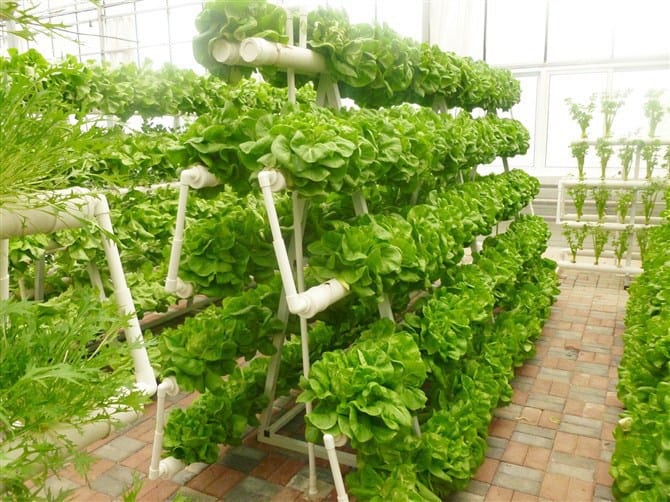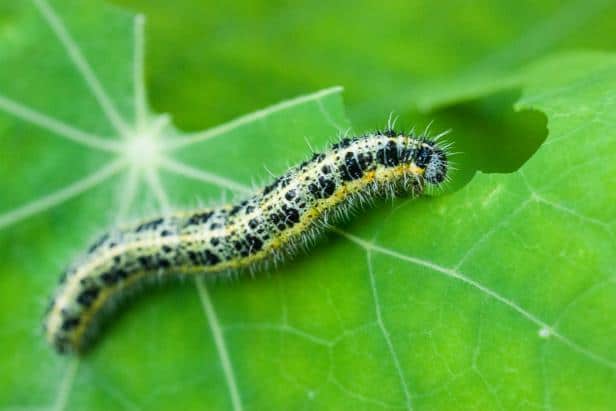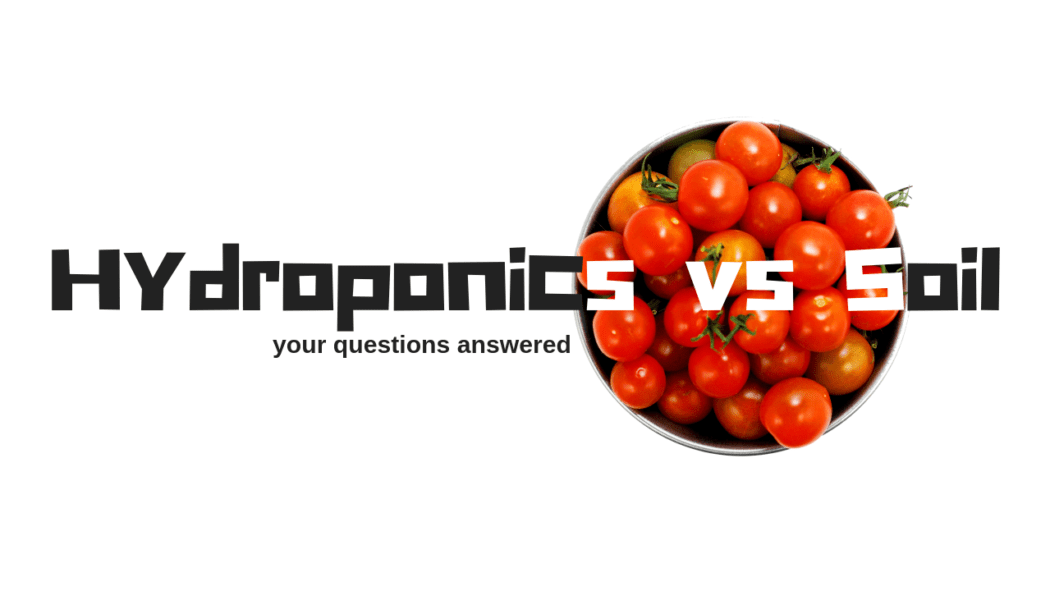From an early age, I can remember my parents planting a large vegetable garden. I’d wander through and enjoy a tomato, snap pea, or the raspberries throughout the summer. Naturally, like many growers, this is where I started my foray into gardening- plain ol’ soil! However, with our short growing season, I was determined to continue growing my own produce throughout the winter, eventually becoming hooked by hydroponics. Now, with the increase in popularity of hydroponics, the question becomes: hydroponics vs. soil, which is really better?
Before we get into a discussion about which is better, let’s quickly define each growing method. Also, let’s make sure we are discussing actual soil and not potting mix (here is the difference). Soil consists of silt, clay, and sand, with organic matter, and an extremely diverse microenvironment of microorganisms. This contains all of the necessary nutrients to germinate seeds, and sustain plant growth. On the other hand, hydroponics ditches the soil and uses water containing a customized nutrient solution to induce plant growth. At the same time growing media is used to to support the plant from seed through harvest.
1. Hydroponics saves water
This is by far and away the most important difference when discussing hydroponics vs. soil. Water is at an all time shortage, and the more we can save and put to the best use possible, the better.
Think for a second how the average gardener waters their garden- It is often in 1 of 2 ways. The first (and proper) way is to dump a significant amount of water into their gardens every few days. This ensures good penetration and the development of deep roots. The second and not so proper method is when a gardener stands with their hand sprayer and sprays the soil until it looks sufficiently wet. This group often does this every day, as the water is usually just evaporating. In both cases, only a small portion of the water is actually used by the plant.
Hydroponics allows almost all of the water to be used by the plant for growth. Let’s take deep water culture as an example. Plants are grown in net pots or on floating rafts with their roots extending directly into a nutrient solution (water) below. It’s nearly completely sealed, leaving no water to be “wasted” through leakage or evaporation. The plants use only what they need, and the rest remains in the container for later use.
In essence, hydroponics allows you to reduce your water usage by around 90% compared to conventional soil based growing.
2. Hydroponics saves space
In a typical soil-based garden, a plants roots need to spread out in the soil to gain access to enough oxygen and water. In a hydroponics system, the plants roots are directly submerged in an oxygenated nutrient solution, allowing them to remain much closer together.

Because your plants are sitting directly in a customized nutrient solution, they are getting the perfect supply of nutrients and air at all times regardless of where the roots grow. When your plants roots are able to stay tighter, you can then save space by planting closer together.
In addition, many hydroponic setups allow you to grow vertically, with several layers of crops above one another. Each layer is typically offset in order for light to penetrate the lower levels. Theoretically you could do the same with soil, but can you imagine how heavy it would be!
3. Hydroponics speeds up growth
Yes, you read that right. Using hydroponics will actually speed up the growth of your plants.
Take lettuce for example- from seed to harvest it will take around 60 days on average to mature in soil. With hydroponics you can cut that time in half, and enjoy your lettuce at roughly the 30 day mark.
So why is it that plants grow so well in a hydroponic system? It is almost entirely due to your control. You are giving the plants everything they need to grow, and the perfect conditions every day. Again, lets compare using lettuce. Out of the 60 days to mature lettuce outdoors, how many of them will actually have a consistent temperature around 21 degrees Celcius (~70 degrees Fahrenheit) and sun for 12+ hours a day. My guess is not very many. However, indoors the plants get these perfect conditions day in and day out. Plus there are no droughts and no nutrient deficiencies.
This all translates into perfect continuous growth from seed through harvest.
4. Hydroponics gives you complete control
Part of the reason your plants are growing so fast is because you have complete control. As the grower, you control the temperature, your control the amount and intensity of the light, and you control the nutrients. You can even control the humidity depending on your setup. This let’s you act just like a mad scientist in a lab, tinkering and adjusting these parameters until your grow is just perfect. You become the master of your plant’s environment.
5. Far less pests and disease
The beauty of hydroponic gardening is the lower likelihood of encountering pests and disease. Don’t be mistaken thinking they don’t exist at all, because they do. They are just far less prevalent than in our outdoor gardens.
The biggest threat to our hydroponic systems is usually nutrient deprivation, and thus caused by our own-doing.

6. No weeding!
Many growers love gardening, until it comes time to weeding. When I speak to wannabe gardeners, the largest mental hurdle they have to actually starting is not wanting to weed. I always have great news for this group- start with hydroponics. No weeding necessary!
Does hydroponics change the taste of plants?
This is a complicated comparison. In order to actually understand this question, we must first understand what makes the plant or crop have taste. The nutrients within a leaf, a root, or a fruit create a specific profile, and this profile triggers our sense of taste and smell. The difficult part is our sense of taste and smell are largely subjective from person to person.
So what flavour categories need considering? The common ones are sweet, sour, salty, bitterness, and umami.

Methods to measure flavour
Sweetness can be measured within fruit, leaves, or roots using a refractrometer, and rated by degrees brix (Bx). One degree Brix is 1 gram of sucrose in 100 grams of solution and represents the strength of the solution as percentage by mass.
Another important flavour when examining plants is heat, or spiciness. This is critical when discussing peppers. With peppers we look at the level of capsaicin, which can be determined using HPLC (high performance liquid chromatography) and measured in Scoville heat units (SHU).
After these, measuring sourness or bitterness is very difficult.
The number one reason most people actively avoid eating vegetables is because they are bitter. This is largely due to the phytonutrients present. Phytonutrients are compounds like phenols, isoflavones, flavonoids, terpenes, and glucosinolates. These can boost immune function, help fight cancerous cells, and produce positive health effects overall. However, these often don’t appeal to our taste buds.
How does this all relate to taste?
Some plants produce more phytonutrients than others. This not only helps them fight of pests and disease in the garden, but also increases their beneficial health properties for us. The healthier a plant, the more beneficial compounds present, and thus the more flavour.
So if you were a lettuce grower and wanted to sell more lettuce, what is more important to you- a healthier head of lettuce, or a less bitter head of lettuce? Unfortunately, many large food suppliers have started breeding and selecting for plants with less bitterness, and when examined at a cellular level, these plants also tend to have lower levels of phytonutrients. Therefore, they are at a very basic level, “less healthy” for us. Don’t get me wrong, you should definitely still be choosing the salad for your side.
The bottom line on taste
The healthier a plant is, the more phytonutrients it will produce, and thus the more flavour it will have. To say wether hydroponics or soil produces a tastier plant is next to impossible. At the end of the day, to produce maximum flavour, a plant needs to be it’s healthiest version possible.
What about beneficial bacteria and fungi?

Up until this point it is plainly clear why hydroponics is often the far better option for growing specific types of crops. However, the largest argument from soil growers is that hydroponic systems lack the diverse microenvironment present in soil. This includes bacteria and fungi, and the products and molecules they produce.
There are just as many bacteria and fungi in hydroponics as is soil
Yes, you read that right! Several studies of hydroponic nutrient solutions have found ~10 million (106) colony forming units (CFU) per millilitre (1,2). So let’s compare this to the bacterial levels found in soil. Soil structure varies drastically depending on composition, so for this comparison we’ll use the best soil we have- compost. The culturable bacterial population in the various stages of compost (mesophilic, thermophilic, and cooling) ranged from 105 to 109 CFU per gram of compost (3,4). Similar to bacteria, Waechter-Kristensen and colleagues found between 10 and 1000 fungal forming units per millilitre of nutrient solution (5).
I know comparing grams of compost to millilitres of nutrient solution is not the most direct comparison, however, it’s the best we can do. Regardless, culturable bacteria in hydroponic systems are directly in line with that of compost. Therefore, growing in hydroponic systems is essentially allowing every gardener to grow in pure compost. The fact that not every soil gardener is growing in 100% compost, makes it all even more amazing.
So there you have it!
Not only does hydroponics have some clear advantages over soil based gardening, it also maintains many of the beneficial aspects of growing in soil. Now I’m not about to ditch my wonderful dirt come summer time, it’s like therapy digging in the stuff. But the versatility and sustainability of hydroponics is unparalleled, and it will always be a part of my gardening.
References
1. B. Berkelmann, W. Wohanka, and G. A. Wolf. 1994. Characterization of the bacterial flora in circulating nutrient solutions of a hydroponic system in rockwool. Acta Hortic. 361:372–381.
2. B. Waechter-Kristensen, et al. 1999. Organic compounds and micro-organisms in closed, hydroponic culture: Occurrence and effects on plant growth and mineral nutrition. Acta Hortic. 481:197–204.
3. P. Chandna, L. Nain, S. Singh, and R. C. Kuhad. 2013. Assessment of bacterial diversity during composting of agricultural byproducts. BMC Microbiol. 2013; 13: 99.
4. V. Bess. 2008. Evaluating Microbiology Of Compost 83–85.
5. B. Waechter-Kristensen, S. Caspersen, S. Adalsteinsson, P. Sundin, and P. Jensén. 1999. Organic compounds and micro-organisms in closed, hydroponic culture: Occurrence and effects on plant growth and mineral nutrition. Acta Hortic. 481:197–204.


thanks for writing
I love gardening but where I live is mostly dry. I carry lots of water, some of my veggies are a waste of time. I like hydroponic but the ingredients to use I would like for someone to enlighten me as what to get and how to use it thanks
Hydroponic is too expensive both money and time, and not all people can afford that, while in natural soil gardening is less expensive
Hydroponic growing does not need to be very expensive, but I do agree it costs more. There is a time and place for both methods. I am unable to grow outdoors year round where I live, and I can grow a lot more in an indoor hydroponic setup than I ever could in soil. I just have a simple deep water hydroponic system. The cost to set it up was a few hundred dollars but I would argue that I we have easily produced enough food to cover that cost over the past year.
What grow lights are you using, being that the lights have a lot to do with both hydro and dirt in cutting growth time, is dirt with chemicals a sufficient way compared to hydro with chemicals ???
Hi Ray- I am using a full spectrum LED light setup. You bring up a great point that environment has a huge impact in growth rate and quality. You also have an interested question with regards to adding nutrients to soil (much like you would fertilizer) to see if it has an impact. I am going to test this out with some controls tomorrow when I start my next batch of seeds. Thanks for posting!
Thanks for Posting lot of Information on Hydroponics.Please continue posting information on the above Topic as it saves lot of Water Wastage.
Hey. Thank you for an interesting post.
I’m new to this so bear with me. I live in Thailand and on the hunt for organic vegetables. You make a compelling case for hydroponics but farmers I’ve talked to here say if they should be be able to meet the standards of organic you almost always have to go with soil. I got no more elaboration than that. Have any insights?
Also, when it comes to lettuce I heard that lettuce grown in soil lasts longer than in hydroponics when harvested. Is that right?
Thank you and I’m looking forward to your comments.
Hi Niklas, thanks for contributing to the community.
Whether or not hydroponics can be considered organic might be one of the most heated debates right now. It largely comes down to what nutrients you are using. Many organic soil based farms still use pesticides, etc, as long as they are organically based (natural) without needing a chemical synthesis (think Copper sulfate or Boron). Therefore, in my view if you can say the same about your hydroponic nutrients, then there is no reason it shouldn’t be considered organic. However, I am only one person and there are many opinions on this topic.
As far as how long lettuce plants last after harvest, I am actually setting up some tests right now to examine this (among other questions). My past life as a scientist likes to continue experimenting. It won’t be an exhaustive test, but it should give me a pretty good idea. I’ll write a post or create a Youtube video when it is complete, so join the community here or subscribe on Youtube so you don’t miss it.